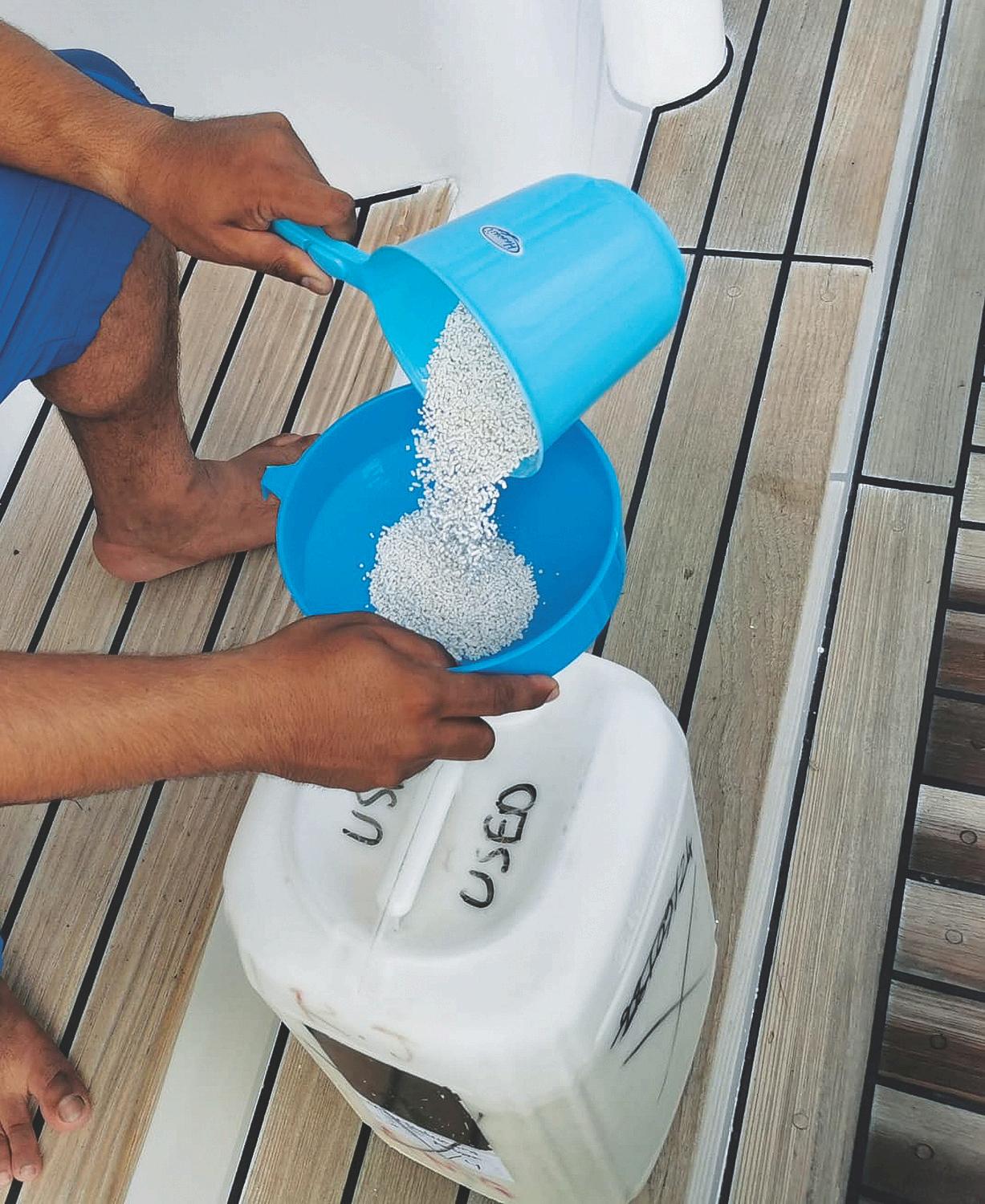
4 minute read
USED REBREATHER SCRUBBER DISPOSAL
TEXT BY FRAUKE TILLMANS, PHD, AND SEPH FOX
The sorb, or scrubber, plays a critical role in rebreather diving. It is responsible for removing carbon dioxide (CO2) from the diver’s breathing gas. Small granules or pellets absorb exhaled CO2 and allow oxygen to pass through. This chemical process allows rebreathers to recycle exhaled air, limiting gas consumption and allowing longer dives.
Once the sorb is saturated, the diver must dispose of it. Due to local regulations, the disposal method can differ by the chemical makeup of the scrubber used and by region. Knowledge of the sorb and its chemical components is important for both safe rebreather diving and environmentally responsible practice.
How Scrubber Works
Soda lime, the most common scrubber material, contains a mixture of calcium hydroxide and sodium hydroxide. When the diver exhales, CO2 travels through the loop and into the canister containing the scrubber pellets or granules. The CO2 reacts with the hydroxide ions in the sorb and forms bicarbonate ions, which then react with the calcium hydroxide and produce calcium carbonate.
In this process, the calcium carbonate stays trapped in the sorb, and the used hydroxide ions are regenerated so they can continue to react with more CO2. After prolonged use, the sorb becomes saturated with calcium carbonate and needs replacement. Different factors, such as water temperature, the diver’s workload, and the type and particle size of the pellets, can impact the sorb’s lifetime.
Scrubber Disposal
Because of the chemicals involved, divers should consider how they dispose of sorb. It has been hypothesized that the calcium hydroxide in the sorb may harm marine life and ecosystems if dumped into the water, but firm evidence is lacking. The International Convention for the Prevention of Pollution from Ships (MARPOL), which the United States has endorsed and used to align federal law, prohibits throwing any garbage into the water “from a vessel that is on a lake, river, stream, or any coastal waters up to 3 miles offshore.”
In the U.S., used sorb is often errantly considered nonhazardous and discarded in regular municipal waste. Depending on the exact chemical composition of the used scrubber material, this practice may be both illegal and environmentally harmful. While the scrubber material is typically composed entirely of nonhazardous calcium carbonate at the end of a dive, it may contain some environmentally toxic sodium hydroxide and, therefore, not be suitable for regular municipal disposal. Sodium hydroxide is considered hazardous waste and must be disposed of properly at a local hazardous waste collection site, which is typically located near landfills.
According to the U.S. Code of Federal Regulations (CFR Title 40, Part 261), the generator of the potentially hazardous waste (in this case, the rebreather diver) must ultimately determine the material's contents and dispose of it in accordance with all local, state, and federal regulations.
Rebreather divers who dive in various locations must ensure they understand all applicable laws and practices for each jurisdiction where they generate, store, and dispose of potentially hazardous waste.
Best Practices
Regardless of your location, there are a few best practices to keep in mind. Always follow the disposal guidelines provided by the manufacturer of the sorb or the rebreather, and confirm that this method of disposal is in accordance with all local, state, and federal disposal laws.
While rebreather and sorb manufacturers may provide guidance for disposal, it is ultimately the diver's responsibility to determine if their used sorb is considered hazardous waste and to dispose of it in compliance with all applicable laws and regulations.
Call for Research Proposals
If you are a scientist interested in researching the effects of sorb on aquatic environments, consider applying for funding through the DAN research grant program. Please email us at research@dan.org.










